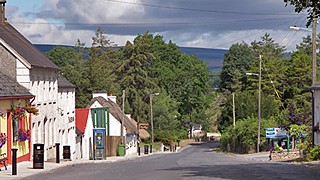Coolrain
- Co. Laois
- Listed in Villages

About 7 kilometres from Mountrath, Coolrain is an historic village close to the ruins of the ancient monastery of Anatrim, which had associations with Saint Kavin. The well of Saint Kavin is also located nearby.
A pleasant little village running north south and bounded on both sides of the street by dwellings. It originally had a Royal Irish Constabulary (RIC) barracks, a forge, two mills and at least one shebeen. The RIC barracks was situated on the site of the present timber-pallet plant, and the forge was situated at the southern end of the village on a site now occupied by a dwelling house. The mills were situated on the north of the village where the ruins can still be seen. The shebeen was on the site of the present Sheeran’s pub.
Anatrim Monastery
Anatrim (Eanach Truim, Marsh of the Elder-tree) was the site of an ancient monastery. Being on the left or north bank of the Nore, which, till about the 10th century, formed, at this point, the boundary between Leix and Ossory, it is always referred to, by early writers, as in the former territory. St. Mochaemhog laid the first foundations of a religious establishment at Anatrim, during the second half of the 6th century. The annals of Anatrim monastery, from the time of St. Coemhan, are a perfect blank. The monks probably held on here till the 12th century, when they either became extinct or were set aside, and their chapel was handed over to the secular clergy. William Fitz John, Bishop of Ossory, appropriated the parish of Offerlane to the Abbey of Duiske, in the beginning of the 13th century, and from that time to 1540 the monks of the said abbey held possession of Anatrim
The church of Anatrim, in ruins since about 1832, dates only from about the year 1700, and is, therefore, a purely Protestant foundation. Within it is a mural tablet to a family of the Delaney’s of Ballyfin, who became Protestant in the Penal times. On the upper part of the slab is a shield with the Delaney coat of arms, viz., and two lions supporting a mullet between their foremost paws, crest, a dexter hand grasping a sword.
The pre-Reformation Catholic chapel, entered in the Red Book of Ossory, in a list of Ossory churches of about the year 1510, as “Ecclesia de Enahtrum,” or parish church of Enahtrum, stood on the site now occupied by the ruined Protestant church. It has been all destroyed. A stone-roofed chamber that adjoined it on the north side still remains. This ancient chamber stands north and south, at right angles to the chapel, in such a position that the east walls of both buildings must have been nearly in a line with each other. This building, except where patched here and there with modern masonry, is very ancient. The Sharpes of Round-wood and the Floods of Middlemount converted it into a mortuary chapel, in the 18th century.
A chamber exactly similar to this in design and situation is found attached to the north side-wall of the Hiberno-Romanesque church of the famous Holy island of Monahincha. It served there undoubtedly as a sacristy. A stone stairway led from it to a second storey overhead, probably the Abbot’s room. That the chamber at Anatrim originally served, in like manner, as a sacristy, there can be no question. If, as is most probable it, too, had a second storey, all trace of such and of the stairway leading thereto, was obliterated by the Sharpes and Floods when they set about “converting” the building to their own uses, more than a century ago.
“St. Kavan’s Well,” at which a pattern was held on the 3rd of November down to 1830 or so, is in the hollow about 20 perches north of the churchyard. It is partially covered over by a bullaun known as “St. Kavan’s Stone”. A bullaun is an incised limestone flag lying on the south side of the well. This rock is rough and uneven except on the upper surface, which has an incised circle, 39 in. in diameter, in the centre, with two artificial rectangular cavities below, and the same number of circular cavities above it. It would appear to have been a partially made quern stone.
